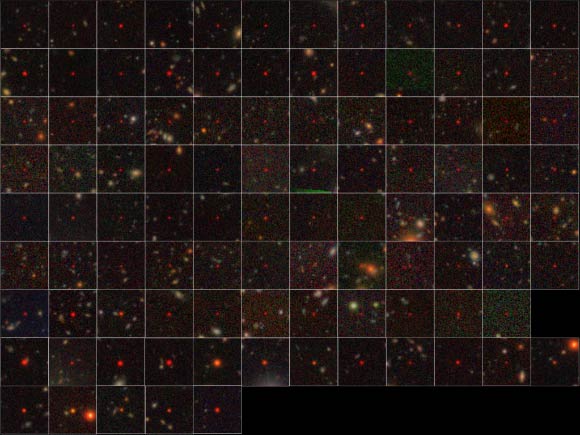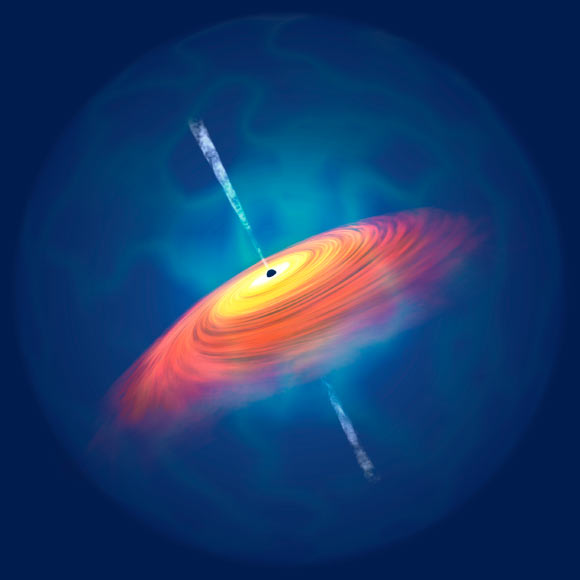Astronomers using the Subaru Telescope have discovered 83 quasars in the distant Universe, from a time when the Universe was less than 10% of its present age.
Supermassive black holes are some of the most powerful objects in the Universe and are found in the centers of galaxies. They can be millions or even billions of times more massive than the Sun. While they are prevalent today, it is unclear when they first formed, and how many existed in the distant early Universe.
A supermassive black hole becomes visible when gas accretes onto it, causing it to shine as a quasar.
Previous studies have been sensitive only to the very rare, most luminous quasars, and thus the most massive black holes.
“The quasars we discovered will be an interesting subject for further follow-up observations with current and future facilities,” said Dr. Yoshiki Matsuoka, an astronomer at Ehime University, Japan.
“We will also learn about the formation and early evolution of supermassive black holes, by comparing the measured number density and luminosity distribution with predictions from theoretical models.”
“It is remarkable that such massive dense objects were able to form so soon after the Big Bang,” said Princeton University’s Professor Michael Strauss.
“Understanding how black holes can form in the early Universe, and just how common they are, is a challenge for our cosmological models.”

The 100 quasars identified from the Hyper Suprime-Cam data: the top seven rows show the 83 newly discovered quasars while the bottom two rows represent 17 previously known quasars in the survey area; they appear extremely red due to the cosmic expansion and absorption of light in intergalactic space. Image credit: National Astronomical Observatory of Japan.
Dr. Matsuoka, Professor Strauss and their colleagues used data taken with the Hyper Suprime-Cam (HSC) instrument on the Subaru Telescope of the National Astronomical Observatory of Japan, which is located on the summit of Maunakea in Hawaii.
The astronomers selected distant quasar candidates from the sensitive HSC survey data.
They then carried out an intensive observational campaign to obtain spectra of those candidates, using three telescopes: the Subaru Telescope; the Gran Telescopio Canarias on the island of La Palma in the Canaries, Spain; and the Gemini South Telescope in Chile.
The survey revealed 83 previously unknown very distant quasars. The most distant quasar discovered by the team, HSC J124353.93+010038.5, is 13.05 billion light-years away, which is tied for the second most distant supermassive black hole ever discovered.
Together with 17 quasars already known in the survey region, the team found that there is roughly one supermassive black hole per cubic giga-light-year — in other words, if you chunked the Universe into imaginary cubes that are a billion light-years on a side, each would hold one supermassive black hole.
“It is widely accepted that the hydrogen in the Universe was once neutral, but was reionized — split into its component protons and electrons — around the time when the first generation of stars, galaxies and supermassive black holes were born, in the first few hundred million years after the Big Bang,” the researchers said.
“This is a milestone of cosmic history, but we still don’t know what provided the incredible amount of energy required to cause the reionization.”
A compelling hypothesis suggests that there were many more quasars in the early Universe than detected previously, and it is their integrated radiation that reionized the Universe.
“However, the number of quasars we observed shows that this is not the case,” said Dr. Robert Lupton, an astronomer at Princeton University Observatory.
“The number of quasars seen is significantly less than needed to explain the reionization.”
“Reionization was therefore caused by another energy source, most likely numerous galaxies that started to form in the young Universe.”
The findings appeared in a series of five papers in the Astrophysical Journal Letters, the Astrophysical Journal, the Astrophysical Journal Supplement Series, and the Publications of the Astronomical Observatory of Japan.
_____
Yoshiki Matsuoka et al. 2019. Discovery of the First Low-luminosity Quasar at z > 7. ApJL 872, L2; doi: 10.3847/2041-8213/ab0216
Yoshiki Matsuoka et al. 2016. Subaru High-z Exploration of Low-luminosity Quasars (SHELLQs). I. Discovery of 15 Quasars and Bright Galaxies at 5.7 < z < 6.9. ApJ 828, 26; doi: 10.3847/0004-637X/828/1/26
Yoshiki Matsuoka et al. 2018. Subaru High-z Exploration of Low-Luminosity Quasars (SHELLQs). II. Discovery of 32 quasars and luminous galaxies at 5.7 < z ≤ 6.8. Publications of the Astronomical Society of Japan 70 (SP1): S35; doi: 10.1093/pasj/psx046
Yoshiki Matsuoka et al. 2018. Subaru High-z Exploration of Low-luminosity Quasars (SHELLQs). IV. Discovery of 41 Quasars and Luminous Galaxies at 5.7 ≤ z ≤ 6.9. ApJS 237, 5; doi: 10.3847/1538-4365/aac724
Yoshiki Matsuoka et al. 2018. Subaru High-z Exploration of Low-luminosity Quasars (SHELLQs). V. Quasar Luminosity Function and Contribution to Cosmic Reionization at z = 6. ApJ 869, 150; doi: 10.3847/1538-4357/aaee7a








